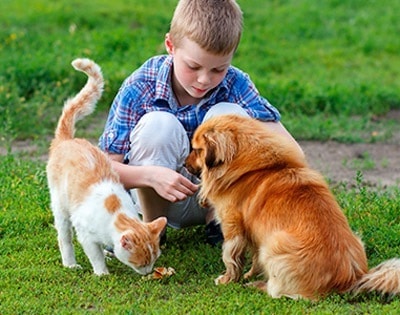
What are Zoonotic Diseases?
Zoonotic diseases are illnesses that can be transmitted between animals and humans. Some of the more well-known zoonoses in the animal care industry include giardia, cat scratch disease (CSD), leptospirosis, rabies, and ringworm. Furthermore, while the risk of humans contracting canine influenza is very low, the influenza virus is ever-changing and adaptable, so not impossible.
Aerapy Animal Health’s UV sanitizing technology achieved a >99.9% kill rate against tested viruses and bacterial pathogens.
Visit our Research & Studies page to learn more.
What causes the spread of zoonotic diseases?
As the human-animal bond continues to grow and as the human population continues to expand geographically, as described by the American Veterinary Medical Association, “the contact between human and wild animal habitats increases, introducing the risk of exposure to new viruses, bacteria and other disease-causing pathogens.”
As noted by the World Organization for Animal Health, five new human diseases appear every year, three of which are of animal origin. Some of these new diseases will make big headlines, but most will stay under the radar, known only to those humans impacted, their medical care providers, and a few dedicated researchers. The infection control protocols you have in place are protecting you, your staff, and the animals in your care not only from known pathogens but unknown ones as well.
How are zoonotic diseases transmitted?
First, the disease must make the jump from animal to human (the most likely scenario). A zoonotic disease can be directly transmitted through bites and saliva (e.g., rabies). Zoonotics can also be spread through the air. For example, swine flu and avian flu can be transmitted from animals to humans, typically those with a close association (e.g., farmers, handlers, veterinarians), through respiratory droplets. Although extremely rare, kennel cough (Bordetella bronchiseptica) likewise can be transmitted from dog to human. In this instance, humans most at risk are those with weakened immune systems (e.g., have autoimmune disease or are going through chemo). In some zoonotic diseases there may be an intermediary host carrier that shows no signs of the disease but can transmit it. A simple example of a host carrier is a mosquito.
Next, once the zoonotic disease has infected the human, the disease can continue to spread to other humans via the usual transmission routes: airborne, direct contact, and surfaces.
How can transmission of zoonotic diseases be prevented?
Because of the human-animal bond, in protecting animal health and welfare, animal care providers contribute toward improving human health. The interdependence of human health and animal health has led to an initiative known as “One Health” which takes an integrative approach to attain optimal health for people and animals, as well as the environment.
Simply put, optimal health for both humans and animals requires an approach beyond considering human to human or, separately, animal to animal transmission. Rather, it requires understanding the human-animal bond.
In October 2019, the American Association of Feline Practitioners (AAFP) released their updated Feline Zoonoses Guidelines. In publishing the guidelines, the AAFP aims to provide accurate information about feline zoonotic diseases to owners, physicians, and veterinarians to allow logical decisions to be made concerning cat ownership. Further, as announced by the AAFP, the guidelines provide “a document that can be used to support the International One Health movement, that is a globally recognized practice of studying the similarities in disease processes between humans and animals.”
How can further spread of zoonotic diseases be prevented?
Preventing the spread of zoonotic diseases also requires understanding transmission routes and how zoonotic pathogens can be mitigated. For example, droplets expelled by coughing or sneezing may become aerosolized into smaller particles. These infective particles are small enough to evaporate quickly and become aerosolized, traveling on dust particles and remaining infective for hours, days, or weeks depending on the particular pathogen.
As explained on our Science Behind UV page, ultraviolet germicidal irradiation can help prevent the spread of zoonotic pathogens, but each particular environment needs its own assessment. While zoonotic pathogens are of concern in virtually all environments, the array of zoonotic pathogens of concern may be greater in animal care environments. Whether a veterinary hospital or clinic, boarding facility, doggie daycare, animal shelter, or chicken farm, the zoonotic pathogens of most concern to your animal care environment should be scrutinized to determine their kill rates and the subsequent reduction in airborne transmission possible when a UV disinfection system is installed. To discover what’s right for your animal care environment and your infection control strategy, contact us to learn more about our UV products.






